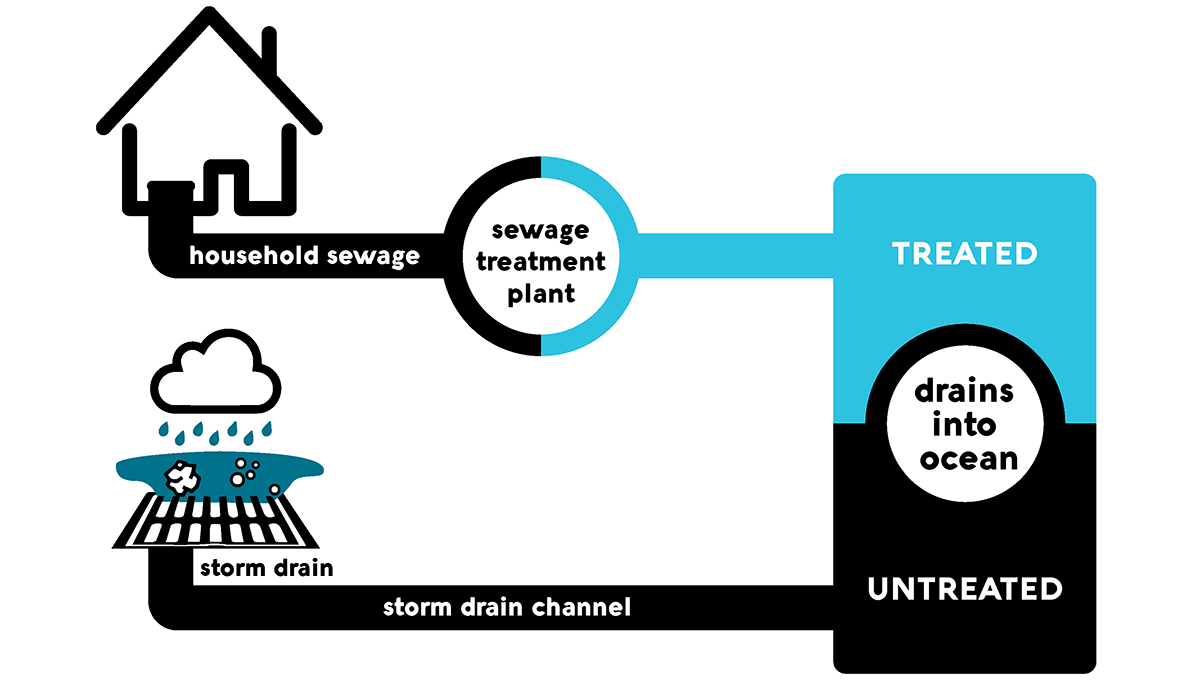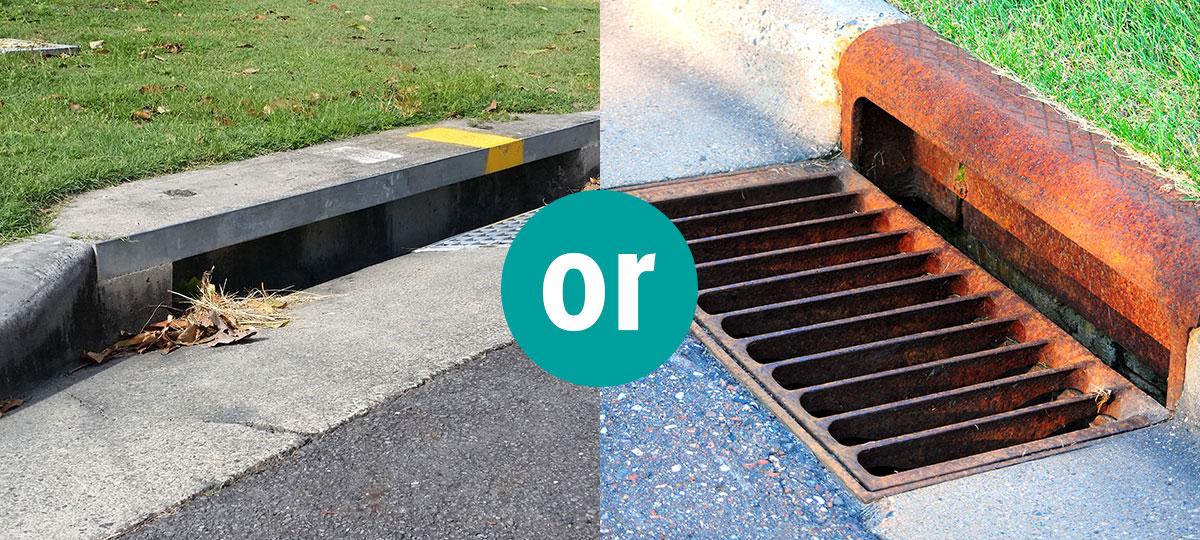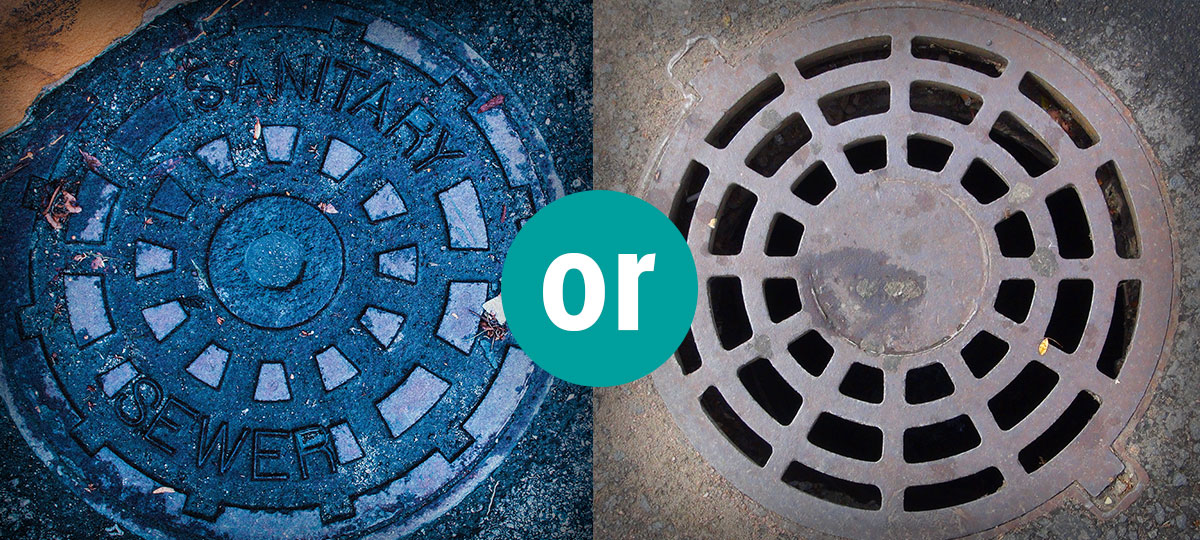Storm Drain vs. Sewer: What’s the Difference?
September 30, 2020
Do YOU know the difference between a storm drain and a sewer drain?
You’ve probably passed by them countless times. Kids play near them. Neighbors pass by them when walking the dog or driving to work. They often get taken for granted, but they protect our streets, curbs, and neighborhoods. There are over ten thousand storm drain inlets in Orange County. Even though there may not seem to be a difference, when you compare a storm drain vs. a sewer drain, they are in fact quite different. Read on to learn more about why a storm drain shouldn’t be confused with a sewer drain.
How is a storm drain different than a sewer drain?
Every time you step outside your home or business, you cross an important threshold. Water outside our homes and businesses is carried by the storm drain system into our creeks, rivers, and ocean. This water flows through underground pipes or open ditches and is not treated or cleaned before discharging into local waterways and eventually the ocean.
Water inside our homes and businesses (from sinks, bathtubs, washing machines, and toilets) is carried by the sanitary sewer system. This water is channeled to a wastewater-treatment facility where it is treated or cleaned before being released to the ocean.

What is the storm drain system?
The storm drain system is designed to quickly carry rainwater or runoff away from hard impermeable surfaces like our driveways, streets, parking lots, and roofs to prevent flooding. As runoff flows into the storm drain system, it can pick up common pollutants such as trash, pet waste, yard debris, fertilizers, pesticides, paints/home solvents, engine oil, and detergents. Since water in the storm drain system is not treated, these pollutants can contain harmful bacteria, cause ecological problems, and be toxic to human, plant and aquatic life. It is important to prevent pollutants from entering the storm drain system in Orange County so we can protect and enjoy our beautiful waterways, beaches, and ocean.
How can water in the storm drain system travel all the way to the ocean?
Water in the storm drain system travels through underground pipes, open ditches, and flood control channels designed to carry water and “channel” it to the ocean. There are more than 350 miles of managed flood control channels in Orange County – about the same distance as a road trip from Los Angeles to San Francisco! There are also over 2,400 outfall or discharge points where water leaves the storm drain system into a local waterbody. All outfalls in our storm drain system drain to our ocean. This means the actions you take to prevent runoff pollution at your home or business make a big difference. For Orange County residents, the ocean truly begins at your front door.
How can you protect our storm drain system from runoff pollution?
There are a variety of simple actions you can take to prevent pollution from entering our storm drain system. Pollutants found in Orange County waterways include trash, pet waste, yard debris, fertilizer, pesticides, engine oil, paints/home solvents, and detergents. Check out the following tips to protect our waterways from pollution:
- Trash: When trash enters our waterways, it can create water flow problems and contaminate aquatic habitats. Secure lids on trash and recycling bins to prevent debris from blowing away. Be particularly mindful of throwing away plastic wrappers, as this is the most common item found on beaches. Remember to reduce, reuse or recycle products whenever possible.
- Pet waste: Picking up after your pet is not just polite, it helps prevent runoff pollution! Pet waste contains harmful bacteria that pollutes our waterways. Always pick up after your pet and dispose of pet waste in a covered trash bin.
- Yard debris: It’s important to prevent yard debris from entering storm drains as it can clog inlets and obstruct water flow, leading to flooding and erosion, and also harbor and transport other pollutants. Instead of rinsing debris off impermeable surfaces like your driveway or street, collect all debris and properly dispose of it in a green waste bin or, better yet, compost it.
- Fertilizers: If improperly applied, fertilizers can enter our waterways and cause algal blooms. Use only the recommended amount and never use when it is windy or within 48 hours of a forecasted rain event. Consider planting OC garden-friendly plants that are adapted to local growing conditions and require fewer chemicals to thrive.
- Pesticides: When pesticides enter our waterways, they can be dangerous to human health and aquatic life. Use only the recommended amount and never use when it is windy or within 48 hours of a forecasted rain event. Instead of reaching for pesticides that may contain pollution-causing chemicals, use least-toxic alternatives or Integrated Pest Management (IPM) which focuses on the long-term prevention of pests through a combination of techniques. Check out our previous article and Responsible Pest Control brochure to learn more.
- Paints and home solvents: Paints and home solvents, including many common household cleaners, contain chemicals that are toxic to humans and aquatic life. They should never be put in storm drains, sewers or septic systems. Instead, dispose of these materials free of charge at your local Orange County household hazardous waste collection center.
- Engine oil: If engine oil enters our waterways, aquatic animals and plants can be negatively affected. Prevent oil and other toxic substances from entering our storm drains by properly maintaining your car. Make repairs immediately, check frequently for leaks, and clean affected areas using absorbents (like kitty litter). Recycle used motor oil at your local recycling center. For additional information on maintaining your vehicle to prevent water pollution, check out our previous article and Tips for the Home Mechanic brochure.
- Detergents: If phosphorus from detergents enters our waterways, it can cause ecological problems, including fish kills. If you are using detergents for outdoor cleaning projects such as washing cars, do not allow wash water to reach the storm drain system. Instead, visit your local car wash or wash your car on permeable surfaces like your lawn which allows water to infiltrate instead of running off your property.
Remember, when it comes to our storm drain system, only rain should go down the drain!
The next time you’re out and about, see how many elements of our storm drain system you can identify. What do storm drain inlets in your neighborhood look like? Are there flood control channels near your community? To further reduce pollution and protect our waterways, you can even adopt a channel.

Understanding the difference between storm drain vs. sewer systems is important for preventing stormwater pollution and preserving the quality of our waterways. For more information about stormwater pollution prevention, visit our Runoff101, Report Pollution, and Illegal Discharges pages and then test your Stormwater IQ!
Did this article help you understand the differences between storm drain vs. sewer systems? Have more questions about how to prevent pollutants from entering the storm drain system? Let us know in the comments.

What an interesting and well documented article. Concepts and examples are clearly explained, and presented in an orderly way, easy to understand. Thank you…!!!
The flooding in Fort Lauderdale would be a lesser problem if the public cleaned up all the trash,plastic bags and debris prior to a major rainstorm or a hurricane, as soon as we saw the street start to flood we cleaned out our storm drain and we were saved by the flooding rain, others not so lucky…
H2OC Stormwater Program Post author
Hi Ricardo, while we are the stormwater program for Orange County California, we thank you for your commitment to protecting waterways. Keeping storm drains clear of litter and debris helps prevent flooding.